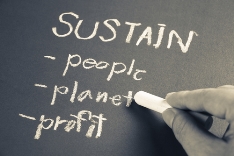 At many corporations, the impact of sustainable business practices has been nothing short of amazing. Fueled by new technologies like , , and , every industry has a major success story. companies are saving considerable amounts of money with more efficient processes. are improving power plant operations through advanced demand and supply approaches. are proactively managing supply chains. companies are co-innovating down the entire value chain with raw materials providers on sustainable production methods.
At many corporations, the impact of sustainable business practices has been nothing short of amazing. Fueled by new technologies like , , and , every industry has a major success story. companies are saving considerable amounts of money with more efficient processes. are improving power plant operations through advanced demand and supply approaches. are proactively managing supply chains. companies are co-innovating down the entire value chain with raw materials providers on sustainable production methods.
In fact, Peter Graf, Chief Sustainability Officer and Executive Vice President of Sustainability Solutions at SAP, reports a seismic shift in how companies view sustainability and the broader effect that sustainable practices have on the market at-large. “It’s no longer just about what takes place within the organization’s four walls. Companies are now putting sustainability at the core of how they create value and in doing so, they are changing entire industries.”
Graf is most excited about how SAP is taking innovation and making it relevant, not just environmentally but also economically.
“We want our software to become more supportive of the circular economy while preserving environmental protection and social equity. With a clean cloud, we’ve managed to make sustainability extremely relevant in the biggest and most important growth area of the company. This is about moving sustainability into the core of value creation where it matters most for SAP and our customers.”
SAP’s sustainability results are documented in its just released second Integrated Annual Report 2013. Although the recent SuccessFactors and Ariba acquisitions increased SAP’s greenhouse gas footprint, Graf says the company’s commitment to 100 percent renewable energy in its data centers and facilities will realign emission levels to the company’s sustainability objectives moving forward. “Many of our on-premise customers will move to the cloud. With our 100 percent renewable commitment we expect to take our customer’s emissions out of the equation.”
Indeed, one of the major challenges companies have is squaring sustainability objectives with business growth realities. The stakes are especially high in the technology industry. For example, the Global e-Sustainability Initiative (GeSi) reports that the data center is the fastest growing consumer of energy within the IT industry, increasing just over seven percent each year. IT overall will consume 30 billion megawatts of electricity by 2020. The need for balance is top of mind for SAP says Graf.
“We had a great year from a business perspective, and sustainability is always about balancing financial, environmental, and social impact. SAP has experienced enormous growth, along the change in our business model in becoming a cloud company."
The tight connection between innovation and sustainability is inarguable. As technologies like big data, mobile, and cloud fundamentally change business processes, creating more profitability, companies like SAP are finding that these innovations can be equally instrumental to help increase environmental and corporate social performance.
Follow me @smgaler
Related posts:
SAP’s TwoGo Ride-Sharing App Puts the Brakes on Costs, Revs Up Engagement
Students Disrupt Energy Industry: Winners of SAP Utility of Tomorrow Contest
Millennials are Big Winners of SAP Connected Car Contest 2013
